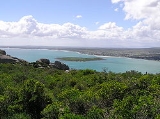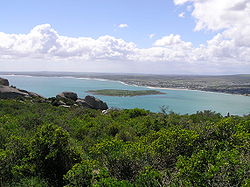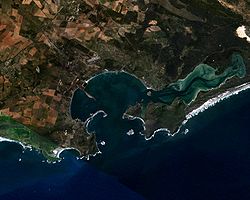
Langebaan
Encyclopedia
Langebaan is a town in the Western Cape
province of South Africa
on the eastern shore of Langebaan Lagoon.
Langebaan is situated 120 km north of Cape Town
, just off the R27
, about 28km from Vredenburg
and 20km from Saldanha Bay
. The Lagoon stretches for 17km from Saldanha Bay, past Langebaan, to Geelbek in the South, and in places is up to 4km wide.
 The Langebaan Lagoon was formed by the rising and falling of sea levels during pre-historic times. This is unlike most lagoons which form where fresh water rivers enter the sea. As a result, Langebaan Lagoon is a purely salt water lagoon.
The Langebaan Lagoon was formed by the rising and falling of sea levels during pre-historic times. This is unlike most lagoons which form where fresh water rivers enter the sea. As a result, Langebaan Lagoon is a purely salt water lagoon.
 As far back as 500 000 years ago, early Homo sapiens were probably present in the area, living in groups and hunting small game, displacing carnivores, such as lions, from their kills and gathering plant foods. They made fire as protection and for cooking and probably made simple shelters from branches. They probably used animal skins for warmth and clothing. They made wooden and stone tools.
As far back as 500 000 years ago, early Homo sapiens were probably present in the area, living in groups and hunting small game, displacing carnivores, such as lions, from their kills and gathering plant foods. They made fire as protection and for cooking and probably made simple shelters from branches. They probably used animal skins for warmth and clothing. They made wooden and stone tools.
The area is rich in historical events from the first inhabitants, the Khoikhoi
and San
, to the arrival of the Europeans. The first European to set foot on land was Vasco da Gama
at St Helena Bay
on the West Coast Peninsula in 1497.
António de Saldanha
, after whom the bay is named, did not enter those waters at all. Juris van Spilbergen mistakenly named it in 1601 as Saldanha Bay; he thought that he had reached Cape Town – originally named Agoada de Saldanha. Although the Dutch were the first to claim ownership of the area, the French were frequent visitors.
Countries would claim ownership by planting a post in the ground and formally declaring ownership. One of these ‘posts’ may be seen today near Geelbek claiming the land on behalf of the Dutch East India Company. European settlement was very limited because of the lack of water for 8 months of the year.
Many stirring events have occurred in the region over the centuries including two sea battles and a visit by the Confederate States of America’s, Alabama
, in 1863, the most feared warship of its day. Even the 5 islands in the area, which are administered by the West Coast National Park, have a history of their own, including battles for ownership, use as smallpox quarantine hospitals, exploits for guano, sealing centres and other activities.
The French used Schaapeneiland (close to Langebaan beach) as a storage place for whale oil and seal hides, calling it "Isle à la Biche". More recently, the whaling station was situated at Donkergat and is still visible from the town. A reminder of Langebaan's whaling history is the harpoon gun outside the Municipal Buildings.
The town Langebaan was founded in 1922 and used as a whaling station until the 1960s.
. The park is most busy during the spring flower season (August to September) when the wild flowers are in bloom. Whales can be spotted during October and November.
The white sand beaches surrounding the clear waters of the Langebaan Lagoon are one of the main attractions of Langebaan. The mild climate and protected waters of the lagoon make Langebaan popular for sailing, kayaking, kitesurfing and fishing, and the town offers numerous holiday facilities for water sport enthusiasts.
To protect its culture as a fishing, holiday and retirement village, the town allows no industries.
Club Mykonos Resort hosts a number of annual events, festivals and exhibitions. Able to accommodate large numbers, the well-known artists are regular performers at this venue. Popular competitions and fund raising events are hosted at the resort.
Large-scale sporting events such as triathlons, the downwind dash, cycling, car gymkhanas and more are held here. A monthly craft market as well as art exhibitions through the year, showcase the talents of local artists. Community events includes the church bazaar and the annual Langebaan Mussel Festival, which takes place on the first weekend of October.
Western Cape
The Western Cape is a province in the south west of South Africa. The capital is Cape Town. Prior to 1994, the region that now forms the Western Cape was part of the much larger Cape Province...
province of South Africa
South Africa
The Republic of South Africa is a country in southern Africa. Located at the southern tip of Africa, it is divided into nine provinces, with of coastline on the Atlantic and Indian oceans...
on the eastern shore of Langebaan Lagoon.
Langebaan is situated 120 km north of Cape Town
Cape Town
Cape Town is the second-most populous city in South Africa, and the provincial capital and primate city of the Western Cape. As the seat of the National Parliament, it is also the legislative capital of the country. It forms part of the City of Cape Town metropolitan municipality...
, just off the R27
R27 (Western Cape)
The R27 is a Regional Route in South Africa that consists of two disjoint segments. The first segment, also known as the West Coast Highway, connects Cape Town with Velddrif along the West Coast. The second runs from Vredendal via Vanrhynsdorp, Calvinia, Brandvlei and Kenhardt to Keimoes on the N14...
, about 28km from Vredenburg
Vredenburg
Vredenburg is a town of the Cape West Coast in the Western Cape province of South Africa. "Vrede" is Afrikaans for peace. It is the transportation and commercial hub of the West Coast area and administrative center of the Saldanha Bay Local Municipality...
and 20km from Saldanha Bay
Saldanha Bay
Saldanha Bay is a natural harbour on the south-western coast of South Africa, north west of Cape Town. The town that developed on the northern shore of the bay, also called Saldanha, was incorporated with five other towns into the Saldanha Bay Local Municipality in 2000. The current population of...
. The Lagoon stretches for 17km from Saldanha Bay, past Langebaan, to Geelbek in the South, and in places is up to 4km wide.
History


The area is rich in historical events from the first inhabitants, the Khoikhoi
Khoikhoi
The Khoikhoi or Khoi, in standardised Khoekhoe/Nama orthography spelled Khoekhoe, are a historical division of the Khoisan ethnic group, the native people of southwestern Africa, closely related to the Bushmen . They had lived in southern Africa since the 5th century AD...
and San
Bushmen
The indigenous people of Southern Africa, whose territory spans most areas of South Africa, Zimbabwe, Lesotho, Mozambique, Swaziland, Botswana, Namibia, and Angola, are variously referred to as Bushmen, San, Sho, Barwa, Kung, or Khwe...
, to the arrival of the Europeans. The first European to set foot on land was Vasco da Gama
Vasco da Gama
Vasco da Gama, 1st Count of Vidigueira was a Portuguese explorer, one of the most successful in the Age of Discovery and the commander of the first ships to sail directly from Europe to India...
at St Helena Bay
St Helena Bay
St Helena Bay is a settlement in West Coast District Municipality in the Western Cape province of South Africa....
on the West Coast Peninsula in 1497.
António de Saldanha
António de Saldanha
António de Saldanha was a Castilian-Portuguese 16th century captain. He was the first European to set anchor in what is now called Table Bay, South Africa, and made the first recorded ascent of Table Mountain.- Background :...
, after whom the bay is named, did not enter those waters at all. Juris van Spilbergen mistakenly named it in 1601 as Saldanha Bay; he thought that he had reached Cape Town – originally named Agoada de Saldanha. Although the Dutch were the first to claim ownership of the area, the French were frequent visitors.
Countries would claim ownership by planting a post in the ground and formally declaring ownership. One of these ‘posts’ may be seen today near Geelbek claiming the land on behalf of the Dutch East India Company. European settlement was very limited because of the lack of water for 8 months of the year.
Many stirring events have occurred in the region over the centuries including two sea battles and a visit by the Confederate States of America’s, Alabama
CSS Alabama
CSS Alabama was a screw sloop-of-war built for the Confederate States Navy at Birkenhead, United Kingdom, in 1862 by John Laird Sons and Company. Alabama served as a commerce raider, attacking Union merchant and naval ships over the course of her two-year career, during which she never anchored in...
, in 1863, the most feared warship of its day. Even the 5 islands in the area, which are administered by the West Coast National Park, have a history of their own, including battles for ownership, use as smallpox quarantine hospitals, exploits for guano, sealing centres and other activities.
The French used Schaapeneiland (close to Langebaan beach) as a storage place for whale oil and seal hides, calling it "Isle à la Biche". More recently, the whaling station was situated at Donkergat and is still visible from the town. A reminder of Langebaan's whaling history is the harpoon gun outside the Municipal Buildings.
The town Langebaan was founded in 1922 and used as a whaling station until the 1960s.
Langebaan today
Bird-watchers visit the area to view the over 300 species of birds found in the lagoon waters of the West Coast National ParkWest Coast National Park
The West Coast National Park lies 120 km north of Cape Town in the Western Cape province of South Africa. It is in size. It is bordered by the Atlantic Ocean on the west and the R27 coastal road, and runs from the town of Yzerfontein in the south up to the Langebaan lagoon...
. The park is most busy during the spring flower season (August to September) when the wild flowers are in bloom. Whales can be spotted during October and November.
The white sand beaches surrounding the clear waters of the Langebaan Lagoon are one of the main attractions of Langebaan. The mild climate and protected waters of the lagoon make Langebaan popular for sailing, kayaking, kitesurfing and fishing, and the town offers numerous holiday facilities for water sport enthusiasts.
To protect its culture as a fishing, holiday and retirement village, the town allows no industries.
Club Mykonos Resort hosts a number of annual events, festivals and exhibitions. Able to accommodate large numbers, the well-known artists are regular performers at this venue. Popular competitions and fund raising events are hosted at the resort.
Large-scale sporting events such as triathlons, the downwind dash, cycling, car gymkhanas and more are held here. A monthly craft market as well as art exhibitions through the year, showcase the talents of local artists. Community events includes the church bazaar and the annual Langebaan Mussel Festival, which takes place on the first weekend of October.

